Toyota Yaris: Locking Lug Nuts (if equipped) / Mounting the Spare Tire
4-Door
- Remove dirt and grime from the
mounting surfaces of the wheel
and hub, including the hub
bolts, with a cloth.
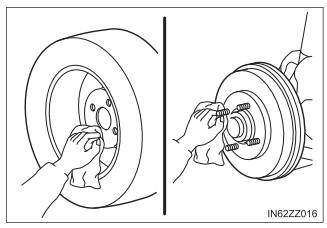
- Mount the spare tire.
- Install the lug nuts with the beveled edge inward; tighten them
by hand.

- Turn the lug wrench counterclockwise and lower the vehicle.
- Use the lug wrench to tighten
the nuts in the order shown.
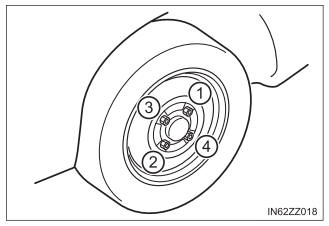
If you are unsure of how tight the nuts should be, have them inspected at your Toyota dealer.

- Open the trunk mat.
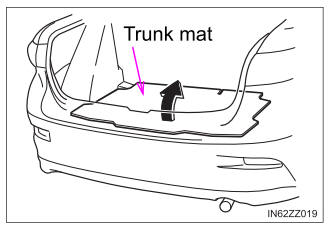
- Remove the belt for securing the flat tire.
- Put the flat tire into the trunk on
the left and toward the back.
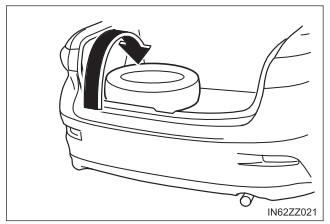
- Fold the rear seatback forward on the right side of the rear seat.
- Unlock the rear seatback on the left side and assure a clearance to pass the belt.
- Pass the belt through the rear
seatback as shown in the figure.
After passing the belt through, return the rear seatback to the original position.

- Pass the buckle through the wheel as shown in the figure and
secure it so that the buckle does not contact the wheel.
Aluminum wheel
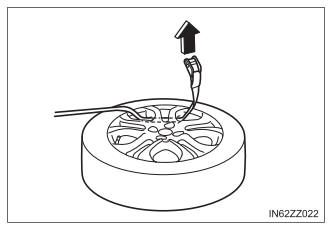
Steel wheel

- Pass the belt through the
buckle, then pull the belt end to
secure the flat tire.

- Return the rear seatback on the right side of the rear seatback to its original position.
- Remove the tire blocks and store the tools and jack.
- Check the inflation pressure. Refer to Tires.
- Have the flat tire repaired or replaced as soon as possible.
5-Door
- Remove dirt and grime from the
mounting surfaces of the wheel
and hub, including the hub
bolts, with a cloth.

- Mount the spare tire.
- Install the lug nuts with the beveled edge inward; tighten them
by hand.

- Turn the lug wrench counterclockwise and lower the vehicle.
- Use the lug wrench to tighten
the nuts in the order shown.

If you are unsure of how tight the nuts should be, have them inspected at your Toyota dealer.

- Remove the luggage compartment cover (if equipped).
Refer to Luggage Compartment.

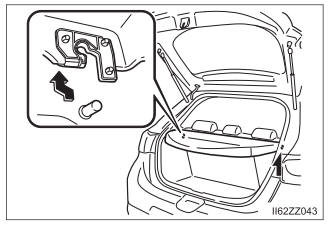
- Remove the belt for securing the flat tire.
- Return the rear seatback to its original position. Refer to Rear Seat.
- Remove the tire blocks and store the tools and jack.
- Remove the center cap by tapping it with the lug wrench.
- Thread the belt through the rear seat as shown in
the figure.


- Place the flat tire in the luggage compartment.

- Thread the buckle through the wheel as shown in
the figure.

- Thread the belt through the
buckle while pressing the tire to
the seatback.
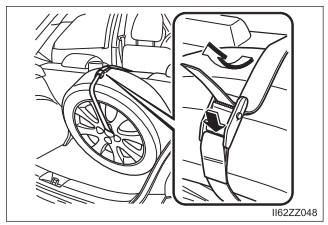
- Pull the belt end to secure the flat tire.

- Insert the luggage compartment cover from the top
of the lug gage compartment opening
with the cloth side of the cover facing outward,
and slide it between the flat tire and the
inside perimeter of the luggage compartment
opening.

- Check the tire inflation pressure. Refer to the specification charts.
- Have the flat tire repaired or replaced as soon as possible.
- Pass the belt underneath the seat belts.

- Do not press the tire pressure monitoring system set switch after installing the spare tire. The switch is only to be pressed after installing the repaired flat tire or installing a replacement tire.
- To prevent the jack and tool from rattling, store them properly.
WARNING
Make sure the mounting surfaces of the wheel, hub and lug nuts are clean before changing or replacing tires
When changing or replacing a tire, not removing dirt and grime from the mounting surfaces of the wheel, hub and hub bolts is dangerous. The lug nuts could loosen while driving and cause the tire to come off, resulting in an accident.
Do not apply oil or grease to lug nuts and bolts and do not tighten the lug nuts beyond the recommended tightening torque
Applying oil or grease to lug nuts and bolts is dangerous. The lug nuts could loosen while driving and cause the tire to come off, resulting in an accident. In addition, lug nuts and bolts could be damaged if tightened more than necessary.
Always securely and correctly tighten the lug nuts
Improperly or loosely tightened lug nuts are dangerous. The wheel could wobble or come off. This could result in loss of vehicle control and cause a serious accident.
Be sure to reinstall the same nuts you removed or replace them with metric nuts of the same configuration
Because the wheel studs and lug nuts on your Toyota have metric threads, using a non-metric nut is dangerous. On a metric stud, it would not secure the wheel and would damage the stud, which could cause the wheel to slip off and cause an accident.
Do not drive with any tires that have incorrect air pressure
Driving on tires with incorrect air pressure is dangerous. Tires with incorrect pressure could affect handling and result in an accident. When you check the regular tires’ air pressure, check the spare tire, too.
 Locking Lug Nuts (if equipped)
Locking Lug Nuts (if equipped)
If your Toyota is equipped with the optional antitheft wheel lug nuts, a
special key must be used to unlock the locking lug nut for each wheel.
The key is stored in the glove compartment, center console storage,
storage box, or trunk...
 Battery Runs Out
Battery Runs Out
Jump-Starting
Jump-starting is dangerous if done incorrectly. So follow the procedure
carefully. If you feel unsure about jump-starting, we strongly recommend that
you have a competent service technician do the work...
Other information:
Toyota Yaris XP210 (2020-2026) Reapir and Service Manual: Removal
REMOVAL CAUTION / NOTICE / HINT The necessary procedures (adjustment, calibration, initialization, or registration) that must be performed after parts are removed, installed, or replaced during the front suspension crossmember sub-assembly removal/installation are shown below...
Toyota Yaris XP210 (2020-2026) Owner's Manual: Communication Settings
S..
Categories
- Manuals Home
- Toyota Yaris Owners Manual
- Toyota Yaris Service Manual
- Engine Start Function When Key Battery is Dead
- Engine & Hybrid System
- Fuse Panel Description
- New on site
- Most important about car
Break-In Period
No special break-in is necessary, but a few precautions in the first 600 miles (1,000 km) may add to the performance, economy, and life of the vehicle.
Do not race the engine. Do not maintain one constant speed, either slow or fast, for a long period of time. Do not drive constantly at full-throttle or high engine rpm for extended periods of time. Avoid unnecessary hard stops. Avoid full-throttle starts.